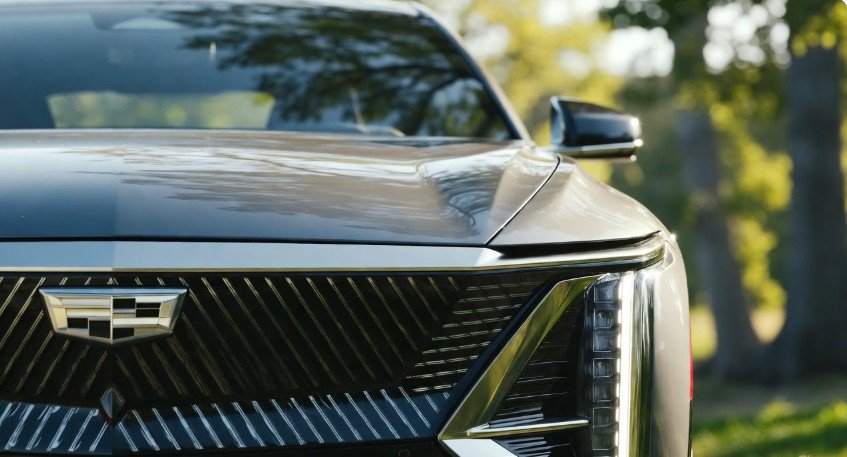What is the Song in the Cadillac Lyriq Commercial? Discover the Enchanting Music!

Have you ever found yourself mesmerized by a commercial—not because of the visuals, but because of the music? That’s exactly what happens when you watch the Cadillac Lyriq commercial. The moment the hauntingly beautiful tune starts playing, it pulls you in. It’s not just background sound; it’s a heartbeat.
So, what is the song in the Cadillac Lyriq commercial that has everyone talking? The answer is “Dream Baby Dream” by Suicide, a song that perfectly matches the commercial’s futuristic feel and emotional pull.
This isn’t just another car ad. It’s an experience—an invitation to dream big and drive into the future. Let’s dive deep into why this song is such a perfect fit, how Cadillac uses music to tell stories, and the magic behind that unforgettable tune.
In This Article
- 1 The Magic Behind “Dream Baby Dream”
- 2 Why Cadillac Chose “Dream Baby Dream”
- 3 Cadillac Lyriq: The Sound of the Future
- 4 The Role of Music in Auto Advertising
- 5 From Underground Classic to Global Spotlight
- 6 Another Version: “Electric Love” and Brand Energy
- 7 How Cadillac Balances Sound and Vision
- 8 Table: “Dream Baby Dream” vs. “Electric Love” – The Sound of Cadillac’s Identity
- 9 Behind the Scenes: Choosing the Perfect Song
- 10 How the Song Shapes Viewer Emotions
- 11 The Song’s Impact on Viewer Engagement
- 12 Music as a Storytelling Tool
- 13 Cultural Significance of the Song Choice
- 14 Bullet Points: Why the Song Works Perfectly for Cadillac Lyriq
- 15 FAQs About the Song in the Cadillac Lyriq Commercial
- 16 Final Thoughts: The Music of Innovation
The Magic Behind “Dream Baby Dream”
The song “Dream Baby Dream” is not new. It was originally created by the American electronic duo Suicide, known for their experimental sound that blends punk, synth, and raw emotion. First released in 1979, the song feels timeless—soft, hypnotic, and emotional.
In the Cadillac Lyriq commercial, the track plays like a whisper of hope. Its repetitive lyrics—“Dream baby dream”—echo like a mantra, encouraging you to believe in something greater. When paired with the Cadillac Lyriq’s sleek electric design, the result is almost cinematic.
The song’s gentle rhythm and emotional tone amplify the luxury of the Lyriq. It’s not loud or aggressive—it’s sophisticated, much like the brand itself. Cadillac didn’t just pick a trending hit; they chose a song that reflects their evolution—classic roots meeting futuristic ambition.
Why Cadillac Chose “Dream Baby Dream”
Music in advertising is never random. Every beat, lyric, and tone serves a purpose. Cadillac’s choice of “Dream Baby Dream” was deliberate—and brilliant.
Here’s why the song works so perfectly:
-
Emotionally charged: The lyrics inspire hope and vision, aligning with Cadillac’s message of innovation.
-
Timeless vibe: The song bridges generations—older audiences feel nostalgia, while younger ones feel inspiration.
-
Futuristic energy: The subtle electronic elements pair beautifully with the Lyriq’s high-tech electric design.
In essence, the track turns the car into more than a machine—it becomes a symbol of dreams realized through technology. Cadillac wanted to communicate progress without losing emotion, and this song captures that spirit flawlessly.
Cadillac Lyriq: The Sound of the Future
The Cadillac Lyriq isn’t just another electric SUV. It’s a statement of where luxury meets innovation. Sleek lines, intelligent design, and an all-electric motor that hums silently—this car feels like the future.
Now, imagine this futuristic vehicle gliding across a modern cityscape, lights reflecting off its polished body, as “Dream Baby Dream” plays softly in the background. The effect is spellbinding. The music transforms the ad into a dream sequence, one that invites you to see driving as more than movement—it’s emotion.
Every aspect of the commercial—from the pacing to the lighting—was designed to move in rhythm with the song. This synchronization makes viewers feel connected, not just to the car, but to the experience of dreaming itself.
The Role of Music in Auto Advertising
Music has always been the invisible storyteller in car commercials. It shapes the emotion, builds anticipation, and creates a memory that sticks. Think of the most iconic car ads you’ve seen—they all had unforgettable soundtracks.
In the case of the Cadillac Lyriq, “Dream Baby Dream” does something remarkable: it humanizes the technology. Electric vehicles often get portrayed as cold or robotic. But Cadillac’s ad changes that narrative.
With this song, the Lyriq feels alive—like it has a soul. The music tells you that driving it isn’t just efficient; it’s emotional. This is how Cadillac differentiates itself from other luxury EVs like Tesla or Audi. Instead of only highlighting specs, they focus on feeling.
From Underground Classic to Global Spotlight
Before the Cadillac Lyriq commercial, “Dream Baby Dream” wasn’t a mainstream hit. It was more of a cult favorite among music enthusiasts. The band Suicide, led by Alan Vega and Martin Rev, was known for pushing boundaries in the late ’70s and early ’80s.
But when Cadillac chose the track, something magical happened—it found a new audience. Suddenly, millions who had never heard of Suicide were Googling the lyrics, searching Spotify, and talking about the song online.
This revival is proof of how powerful advertising can be when it uses authentic music. A 40-year-old song suddenly became the soundtrack of the future, perfectly complementing Cadillac’s vision for the Lyriq.
Another Version: “Electric Love” and Brand Energy
Interestingly, some Cadillac Lyriq campaigns also featured “Electric Love” by BØRNS, another enchanting track that amplifies the car’s energy. This version added a more upbeat, pop-driven vibe to certain regional or digital ads.
While “Dream Baby Dream” evokes emotion, “Electric Love” injects excitement. Its vibrant energy mirrors the electric pulse of the Lyriq. With lyrics about passion and electricity, it’s a clever nod to the EV revolution.
This duality—between dreamy reflection and electric thrill—shows Cadillac’s marketing genius. They’re appealing to both heart and head, merging emotion with innovation. It’s not just about selling a car; it’s about selling a feeling.
How Cadillac Balances Sound and Vision
Creating a commercial like this isn’t just about matching a song to a video. It’s a complex creative process involving sound engineers, branding experts, and music supervisors.
The goal? To find that one piece of music that feels like Cadillac.
During production, the team studies how the car moves, the colors on screen, and the story they want to tell. When “Dream Baby Dream” was tested against visuals of the Lyriq, the synergy was instant. The song’s slow build matched the car’s reveal, and the dreamy vocals mirrored the visual serenity of the electric ride.
Everything—from camera angles to editing rhythm—was built around the song’s mood. It’s this level of harmony that makes the commercial unforgettable.
Table: “Dream Baby Dream” vs. “Electric Love” – The Sound of Cadillac’s Identity
| Feature | “Dream Baby Dream” – Suicide | “Electric Love” – BØRNS |
|---|---|---|
| Mood | Haunting, emotional, reflective | Energetic, modern, upbeat |
| Genre | Synth-punk / Electronic | Indie Pop / Electro-Pop |
| Emotion Evoked | Hope, vision, nostalgia | Passion, excitement, freedom |
| Perfect For | Branding the luxury EV dream | Highlighting modern innovation |
| Used In | Main Cadillac Lyriq campaign | Digital and secondary ad edits |
This combination shows Cadillac’s smart approach—using music to express both sides of the Lyriq’s personality: dreamy luxury and electric excitement.
Behind the Scenes: Choosing the Perfect Song
Behind every memorable car commercial lies hours of creative debate. Cadillac’s marketing team wanted something that reflected both heritage and innovation. They didn’t want a typical pop track or overused cinematic score.
Music supervisors likely auditioned dozens of songs before landing on “Dream Baby Dream”. Once chosen, Cadillac had to secure licensing rights, a process that can take weeks or even months. Negotiations with record labels and artists ensure proper permissions are granted.
This careful process ensures not just legality but emotional fit. Cadillac wasn’t just buying a song; they were investing in an identity. The moment the first note plays, it tells you exactly what Cadillac stands for—dreaming, innovation, and timeless luxury.
How the Song Shapes Viewer Emotions
The true power of “Dream Baby Dream” lies in how it makes you feel. Even if you don’t consciously notice the song, it lingers. The melody seeps into your emotions, subtly influencing your perception of the brand.
When the commercial ends, you don’t just remember the car—you remember the feeling. That’s the magic of good advertising music.
Studies have shown that music can increase ad recall by up to 96%. The Cadillac Lyriq ad uses this psychology masterfully. The calm repetition of “Dream baby dream” leaves viewers with a sense of optimism, mirroring Cadillac’s vision for a cleaner, electric future.
In other words, you’re not just hearing a song. You’re experiencing Cadillac’s dream.
The Song’s Impact on Viewer Engagement
One of the most fascinating aspects of the Cadillac Lyriq commercial is how the song drives viewer engagement. People don’t just watch the ad—they feel it. The hypnotic rhythm of “Dream Baby Dream” encourages viewers to pause, reflect, and imagine themselves behind the wheel of the Lyriq. This emotional connection is priceless in advertising, as it transforms passive viewers into active participants in the brand’s story.
Social media reactions prove the song’s influence. Viewers often comment not on the car specs but on the soundtrack, asking, “What’s the song in the Cadillac Lyriq commercial?” This curiosity leads to online searches, playlist additions, and viral shares. In effect, the music amplifies the ad’s reach, creating organic buzz that no paid promotion alone could achieve. Cadillac cleverly leverages music as a bridge between product experience and emotional engagement, turning viewers into lifelong fans.
Music as a Storytelling Tool
Music does more than entertain—it tells a story. In the Lyriq commercial, “Dream Baby Dream” functions as a narrative guide, creating a rhythm for the visual story to follow. Every soft pulse, electronic shimmer, and lyrical repetition mirrors the Lyriq’s journey from ordinary city streets to a futuristic vision of driving.
By pairing the car’s elegant design with this song, Cadillac communicates subtle messages: luxury is thoughtful, innovation is serene, and technology is humanized. Unlike aggressive advertising that emphasizes speed or power alone, this commercial emphasizes experience—an immersive, emotionally resonant journey that feels both intimate and aspirational.
Cultural Significance of the Song Choice
Choosing “Dream Baby Dream” is more than a marketing tactic; it’s a cultural statement. Suicide was an avant-garde band, pioneering electronic and punk sounds at a time when neither was mainstream. By reviving this track, Cadillac bridges decades of musical innovation, subtly aligning its brand with creativity, experimentation, and bold vision.
This choice signals that Cadillac isn’t just following trends—it’s honoring history while pushing forward. The Lyriq becomes not just a car but a cultural artifact, a symbol of blending heritage with the cutting-edge. For music fans, the commercial is a celebration of rediscovered artistry. For car enthusiasts, it’s a futuristic dream realized.
Bullet Points: Why the Song Works Perfectly for Cadillac Lyriq
-
Emotional resonance: Evokes hope, vision, and curiosity.
-
Timeless appeal: Connects older and younger audiences.
-
Brand alignment: Reflects Cadillac’s innovative yet luxurious identity.
-
Storytelling: Creates a rhythm that mirrors the Lyriq’s journey.
-
Cultural depth: Highlights creativity and historical artistry.
Each point demonstrates that the song was chosen not just for its sound but for its ability to enrich the entire viewing experience.
FAQs About the Song in the Cadillac Lyriq Commercial
1. What is the song in the Cadillac Lyriq commercial?
The song is “Dream Baby Dream” by the American electronic duo Suicide.
2. Why did Cadillac choose this song?
Cadillac chose it for its haunting, emotional tone, which perfectly aligns with the futuristic and luxurious design of the Lyriq.
3. Is “Dream Baby Dream” widely known?
Before the commercial, the song was more of a cult classic. Its inclusion in the ad brought it mainstream recognition.
4. Who created “Dream Baby Dream”?
The song was created by Suicide, an influential duo consisting of Alan Vega and Martin Rev, pioneers in electronic and punk music.
5. Has the song been used in other Cadillac ads?
Yes, Cadillac also explored “Electric Love” by BØRNS for digital and regional campaigns, giving the Lyriq a more upbeat energy.
6. How does the music affect viewers?
The song increases engagement, emotional connection, and brand recall, leaving a lasting impression on audiences.
7. Can I listen to the song online?
Absolutely! “Dream Baby Dream” is available on Spotify, Apple Music, and other major streaming platforms.
8. Does the music choice reflect Cadillac’s brand values?
Yes, it conveys innovation, luxury, and timeless elegance, perfectly mirroring the Lyriq’s identity.
Final Thoughts: The Music of Innovation
At its core, the Cadillac Lyriq commercial isn’t just selling a car; it’s selling a dream. The choice of “Dream Baby Dream” elevates the ad from a simple product showcase to an emotional experience that resonates with viewers. Cadillac’s genius lies in blending technology with art, using music to make innovation feel personal.
Whether you’re a music enthusiast, a car lover, or just someone curious about the magic behind ads, the song leaves an undeniable impression. It’s haunting, timeless, and perfectly suited to the Lyriq’s vision of luxury and progress.
So next time you see the Cadillac Lyriq glide across the screen, listen closely. Let the music guide you, and maybe, just maybe, you’ll feel the dream Cadillac invites every driver to experience.






